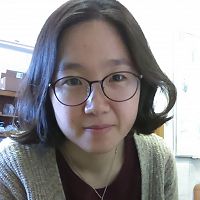Critical Zone Profile – HYOJIN KIM (geochemist, postdoctoral fellow)
26 Sep 2016
Post-doctoral researcher; Global Institute for Water Security; Earth and Environmental Systems Institute, Pennsylvania State University
Hyojin Kim, an aqueous geochemist, is interested in understanding the evolution of Critical Zone (CZ) structure by studying water and rock chemistry. Kim earned her Ph.D. in Earth and Planetary Science at the University of California-Berkeley in 2014. She is currently a postdoctoral researcher at the Pennsylvania State University, working at the Susquehanna Shale Hills Critical Zone Observatory (CZO).
“I am interested in answering questions about what, when, and how particles are moving through the Critical Zone…” - Hyojin Kim
I seek to understand the role of particles (i.e., colloids) in the evolution of CZ structure. Recent studies have emphasized that particles may play a central role in mass fluxes, particularly iron (Fe) and aluminum (Al), in various geochemical systems. However, the underlying processes for the formation and transport of this mobile particle phase in the CZ are not well defined. To better understand the dynamics of particles in the Shale Hills CZO, I focus on capturing the temporal variability of particle and water chemistry at a high resolution during hydrologically dynamic periods (e.g., snow melt, storms).
I am interested in answering questions about what, when, and how particles are moving through the CZ and also quantifying the element fluxes as particles. To answer such questions requires an investigation of mass losses of particles in the zone below the mobile soil layer (e.g., fractured bedrock zone). These particles may be responsible for a significant fraction of chemical weathering fluxes; however, they have rarely been quantified. This study will provide direct measurements of these mass fluxes. Furthermore, such mass losses may create void spaces, resulting in higher porosity. My work may help understand how porosity (or fracture network) evolves and contribute to our knowledge of the evolution of CZ structure.
In practice, particles themselves can cause environmental issues (e.g., air pollution) and also play a key role in transporting contaminants. The methods I use to document temporal variability of particles and water chemistry may also be applicable to monitor the mobilization and transport of solid phase contaminants. This application may help to show how contaminants move through different environment medium and how their fates change along flow paths.
ISCO set-up to collect water and particle samples during snow-melt in the Shale Hills Critical Zone Observatory
The CZO network provides the opportunity for cross-site science, bringing new perspective to my understanding of CZ processes.
The Critical Zone, by definition, is the layer where all the physical, chemical, hydrological, and biological processes occur to shape Earth’s surface. Investigations of this layer would greatly improve our comprehension of Earth surface processes and our ability to predict for the future. For instance, chemical weathering may be integral in sequestrating atmospheric carbon dioxide (CO2) on a geologic time scale by consuming CO2 as a source of protons. Such chemical processes occur in the CZ, therefore investigations of water chemistry evolution will be fundamentally important to better quantify CO2 consumption, particularly under various climate change scenarios.
The CZO network provides the opportunity for cross-site science, bringing new perspective to my understanding of CZ processes. The Eel River and Shale Hills CZOs, which are my Ph.D. and postdoctoral research sites respectively, are underlain by similar lithology (argillite vs. shale), but evolve in different conditions (e.g., climate, geologic history, tectonic settings). The views brought about from interacting with the multi-disciplinary teams at each CZO enhance insight into CZ evolution and enable me to develop my research questions.
CZ research focuses on process-based understanding of both disturbed and undisturbed CZ structure in order to understand how such environments operate and sustain conditions. This foundational research may influence the way in which natural resources are managed. I am interested in contributing to the establishment of sustainable management plans for water quality in developed environments (e.g., urban) based on my research of water chemistry evolution in the CZ.
Gravitational Filtration System. To preserve sample integrity for reactive elements (e.g., Fe, Al, Mn) and collect both water and particle samples, ISCO sample bottles were modified to filter the sample upon sampling by gravity. Details about this sampling method can be found in Kim et al. [2012]
Kim, H., J. K. B. Bishop, T. J. Wood, and I. Y. Fung (2012), Autonomous water sampling for long-term monitoring of trace metals in remote environments, Environ. Sci. Technol., 46(20), 11220–11226, doi:10.1021/es3006404.
Hyojin Kim
ISCO set-up to collect water and particle samples during snow-melt in the Shale Hills Critical Zone Observatory
Gravitational Filtration System. To preserve sample integrity for reactive elements (e.g., Fe, Al, Mn) and collect both water and particle samples, ISCO sample bottles were modified to filter the sample upon sampling by gravity. Details about this sampling method can be found in Kim et al. [2012]
Kim, H., J. K. B. Bishop, T. J. Wood, and I. Y. Fung (2012), Autonomous water sampling for long-term monitoring of trace metals in remote environments, Environ. Sci. Technol., 46(20), 11220–11226, doi:10.1021/es3006404.
News Category:
PEOPLE
Related News
Explore Further







